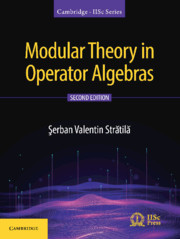Book contents
- Frontmatter
- Dedication
- Contents
- Preface to the Second Edition
- Preface to the First Edition
- Chapter I Normal Weights
- Chapter II Conditional Expectations and Operator-Valued Weights
- Chapter III Groups of Automorphisms
- Chapter IV Crossed Products
- Chapter V Continuous Decompositions
- Chapter VI Discrete Decompositions
- Appendix
- References
- Notation Index
- Subject Index
Chapter I - Normal Weights
Published online by Cambridge University Press: 16 October 2020
- Frontmatter
- Dedication
- Contents
- Preface to the Second Edition
- Preface to the First Edition
- Chapter I Normal Weights
- Chapter II Conditional Expectations and Operator-Valued Weights
- Chapter III Groups of Automorphisms
- Chapter IV Crossed Products
- Chapter V Continuous Decompositions
- Chapter VI Discrete Decompositions
- Appendix
- References
- Notation Index
- Subject Index
Summary
Characterizations of Normality
In this section, we prove the Theorem of Haagerup asserting that every normal weight on a W *-algebra is the pointwise least upper bound of the normal positive forms it majorizes.
Let be a C*-algebra. A weight on is a mapping with the properties
The set
is a face of, the set
is a left ideal of, and the set
is a facial subalgebra of, hence can be extended uniquely to a positive linear form, still denoted by, on the *-algebra
A family of weights on is called sufficient if
and is called separating if
In particular, the weight is called faithful if
Let be a weight on the C*-algebra. The formula
defines a prescalar product on with the properties:
Let be the Hilbert space associated with with the scalar product It follows that there exists a *-representation, uniquely determined, such that
where denotes the canonical mapping. The *-representation is called the GNS representation or the standard representation associated with We remark that
Let be a W *-algebra. A weight on is called normal if
for every norm-bounded increasing net, and lower w-semicontinuous if the convex sets
are w-closed. An important result concerning weights on W *-algebras is the following characterization of normality:
Theorem (U. Haagerup). Let 𝜑 be a weight on the W *-algebra. The following statements are equivalent:
(i) is normal;
(ii) is lower w-semicontinuous;
Later (2.10, 5.8) we shall see that is normal if and only if it is a sum of normal positive forms, in accordance with the definition used in ([L], 10.14).
In Sections 1.4–1.7, we present some general results that will be used in the proof of the theorem; Sections 1.6–1.12 contain the main steps of the proof.
- Type
- Chapter
- Information
- Modular Theory in Operator Algebras , pp. 1 - 98Publisher: Cambridge University PressPrint publication year: 2020



